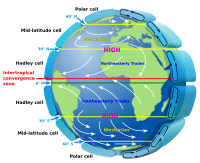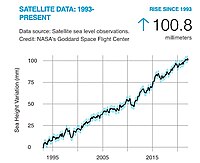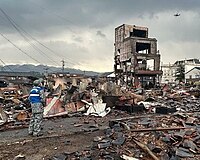
Increasing trend in Japan Sea Throughflow transport
Sign Up to like & getrecommendations! Published in 2020 at "Journal of Oceanography"
DOI: 10.1007/s10872-020-00563-5
Abstract: A long-term increasing trend in the transport of the Japan Sea Throughflow is observed from sea-level differences across the Tsushima Strait. Tidal gauge observations show sea level at Hakata, Japan, increasing at a higher rate… read more here.
Keywords: increasing trend; sea; transport; japan ... See more keywords

The 9–11 November 2013 Explosive Cyclone over the Japan Sea-Okhotsk Sea: Observations and WRF Modeling Analyses
Sign Up to like & getrecommendations! Published in 2020 at "Journal of Ocean University of China"
DOI: 10.1007/s11802-020-4372-x
Abstract: During the period from 9 to 11 November 2013, an explosive cyclone (EC) occurred over the Japan Sea-Okhotsk Sea. This EC initially formed around 18 UTC 9 November over the Japan Sea and developed over… read more here.
Keywords: november 2013; wrf modeling; 2013 explosive; sea ... See more keywords

Magmatic fluids play a role in the development of active gas chimneys and massive gas hydrates in the Japan Sea
Sign Up to like & getrecommendations! Published in 2020 at "Chemical Geology"
DOI: 10.1016/j.chemgeo.2020.119462
Abstract: Abstract The Earth's marine continental margins hold significant amount of carbon in the form of gas hydrate which can interact dynamically with seawater and the atmosphere and potentially influence global climate. It is generally assumed… read more here.
Keywords: gas; hydrate; japan sea; gas hydrate ... See more keywords

Coastal summer eddies in the Peter the Great Bay of the Japan sea: In situ data, numerical modeling and Lagrangian analysis
Sign Up to like & getrecommendations! Published in 2019 at "Continental Shelf Research"
DOI: 10.1016/j.csr.2019.05.002
Abstract: Abstract Coastal mesoscale anticyclonic eddies are regularly generated by the Primorsky Current flowing past the capes in the largest bay of the Japan Sea, the Peter the Great Bay. They were observed in 18 of… read more here.
Keywords: bay japan; japan sea; bay; summer ... See more keywords

Response of lower trophic ecosystem in the Japan Sea to horizontal nutrient flux change through the Tsushima Strait
Sign Up to like & getrecommendations! Published in 2019 at "Estuarine, Coastal and Shelf Science"
DOI: 10.1016/j.ecss.2019.106386
Abstract: Abstract The Japan Sea is a semi-closed sea with straits such as the Tsushima Strait (Korea Strait). The nutrient transport through the Tsushima Strait impacts on the ecosystem around the coast of Japan. We analyzed… read more here.
Keywords: sea; transport; japan sea; tsushima strait ... See more keywords

Seismic evidence of shallow gas in sediments on the southeastern continental shelf of Korea, East Sea (Japan Sea)
Sign Up to like & getrecommendations! Published in 2021 at "Marine and Petroleum Geology"
DOI: 10.1016/j.marpetgeo.2021.105291
Abstract: Abstract High resolution multi-channel seismic reflection data (~1000 km) and multibeam echosounder bathymetry from the southeastern Korean continental shelf of the East Sea (Japan Sea) reveal numerous shallow gas indicators and seepage-related features, such as bright… read more here.
Keywords: gas; sea japan; japan sea; continental shelf ... See more keywords

Simulation of mesoscale circulation in the Tatar Strait of the Japan Sea
Sign Up to like & getrecommendations! Published in 2018 at "Ocean Modelling"
DOI: 10.1016/j.ocemod.2018.04.006
Abstract: Abstract The eddy-resolved ocean circulation model RIAMOM (Lee et al., 2003) is used to analyze seasonal variability of mesoscale circulation in the Tatar Strait of the Japan Sea. The model domain is a vast area including… read more here.
Keywords: mesoscale circulation; sea; circulation; japan sea ... See more keywords

Climate and environmental changes for the past 44 ka clarified by pollen and algae composition in the Ulleung Basin, East Sea (Japan Sea)
Sign Up to like & getrecommendations! Published in 2017 at "Quaternary International"
DOI: 10.1016/j.quaint.2016.09.052
Abstract: Abstract The pollen and algae records derived from core KCES-1 in the East Sea (Japan Sea) reveal vegetation and climate changes during the past 44 ka. From 44 to 36 cal ka BP, forest vegetation in… read more here.
Keywords: sea; ulleung basin; japan sea; east sea ... See more keywords

Orbital-scale vegetation-ocean-atmosphere linkages in western Japan during the last 550 ka based on a pollen record from the IODP site U1427 in the Japan Sea
Sign Up to like & getrecommendations! Published in 2021 at "Quaternary Science Reviews"
DOI: 10.1016/j.quascirev.2021.107103
Abstract: Abstract Climate and vegetation in Japan are strongly influenced by the East Asian Monsoon (EAM) and the ocean environment of the Japan Sea. This study discusses the findings from a new pollen record from Integrated… read more here.
Keywords: japan sea; vegetation; scale vegetation; orbital scale ... See more keywords

Characterization of Submesoscale Turbulence in the East/Japan Sea Using Geostationary Ocean Color Satellite Images
Sign Up to like & getrecommendations! Published in 2019 at "Geophysical Research Letters"
DOI: 10.1029/2019gl083892
Abstract: Submesoscale processes are key in understanding physical and biological phenomena near the surface, but there remains a lack of observational evidence over large areas. We used hourly images from a geostationary satellite that can resolve… read more here.
Keywords: east japan; ocean color; turbulence; surface ... See more keywords

Geodynamic subduction models constrained by deep earthquakes beneath the Japan Sea and eastern China
Sign Up to like & getrecommendations! Published in 2020 at "Scientific Reports"
DOI: 10.1038/s41598-020-62238-x
Abstract: Details of Pacific plate subduction under the Japan Sea and associated current seismicity remain challenging. Seismic tomography reveals a continuous slab dipping at ~30° down to ~600 km, and earthquake mechanisms point to down-dip compression. Further,… read more here.
Keywords: japan sea; subduction; dip compression; slab ... See more keywords